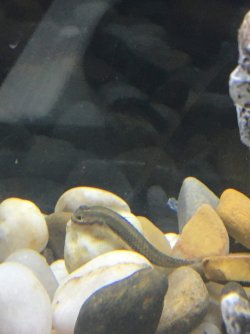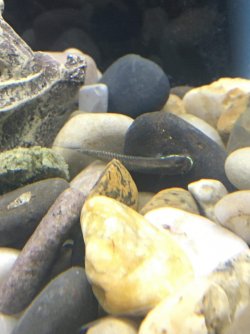Yes, definitely a stiphodon goby species. I've had these and they are wonderful fish, however they should be kept in an older, established aquarium. They eat aufwuchs (tiny plants and organisms that grow on the surfaces of an established aquarium or in the wild), so don't clean the back of your tank glass overly well. From what I've read, they usually starve to death because they can't get enough to eat in a typical aquarium. Keep plants in your tank if you don't already. That helps with nice things to grow. I see you have rocks, which is good. Stuff grows on the rocks as well and the gobies will spend most of their time on the rocks grazing. They can adhere to the glass with their specialized mouth.
Note that they are NOT "algae eaters" so should not be expected to be "clean up crew." Algae and aufwuchs are 2 different things.
I did see mine occasionally nibbling from the Omega One algae wafer that I fed to the cories, but mostly they just ate the mysterious aufwuchs from the glass, rocks, and large plant leaves. The Omega One algae wafer was the ONLY other food I ever saw them eat. They wouldn't go near the regular fish flake or the shrimp pellets.
They also like to have an area where there is strong water flow, because they need highly oxygenated water. I found that the HOB filter that I use provided a lot of water turbulence that they loved. They would sit on the large rock decor immediately underneath the water flow. They went all over the tank, but under the flow seemed to be a favorite spot.
They like to burrow in the sand, so if you have sand, you will occasionally see their little heads peeking out with the rest of their bodies buried. They create little burrows for themselves at night, but you are unlikely to see it since the lights will be out and they are so small. I would every so often see one dart in or out of a burrow. They would excavate a small hole in the sand on the side of a buried rock or large decor and hang out there. I read that care must be taken to completely bury rocks and decor so that the base of the rock/decoration is against the bottom of the tank, so that they don't dig under something and have it collapse on them and kill them. From what I observed in my tank, this was indeed necessary advice.
According to what I read online when I got them, they live about 2 years, but mine lived for about 4 years. The one male I had died within days but I had a group of 6 females for about 4 years. They are territorial, so they need room to get away from each other. That said, I also observed that they liked to hang out near each other fairly often. I never got to see male behavior, since my lone male died so soon after bringing him home, but the females were delightful. In fact, I have to say, these were my favorite fish.
Since this fish is so tricky to feed though, unless the tank is older and planted, I wish they wouldn't sell it. From what I've read, most starve to death in the average aquarium. Also, they are one those species whose young must develop in different waters that can't be replicated in an aquarium, so they are always wild-caught. Because they are picky eaters, they often arrive half-starved to the stores and then the stores can't feed them properly either, so if they aren't sold to the right home soon, they starve to death. That may have been what happened to my male. It makes me sad to think of the little critters living their lives in nature and being scooped up and sent across continents to starve to death.
One thing you can do to encourage aufwuchs is to put some rocks in a small container of water and let them sit in the sun. The sun will encourage the growth of lots of good stuff they can eat. I did that at first because I was really afraid of them starving, but they only ate a little from theses rocks because my tank had already been established for long enough.
If possible, your new little lady (I'm assuming it's female based on color but I could be wrong) would likely be better off in your oldest tank UNLESS it is the tank with the angelfish! The angelfish is very likely to eat the little goby.
The following link has excellent advice regarding how to keep these fish. It's what I used for advice and mine lived for 4 years. The link is specifically for stiphodon atropurpureus, but as mentioned by others above (and in the link), these fish are often mislabeled, and there can be such minor differences between the different varieties, that unless you are an expert, you don't really know what you have. My male looked exactly the atropurpureous, so I assume the females were as well. Yours looks just mine, so I'm assuming you also have the stiphodon atropurpureous. Definitely a stiphodon though.

www.seriouslyfish.com
Another good link (below) is to Rachel O'Leary's site where she has a brief and understandable description of them and their care. She mentions a prepared food that can be given to them, so you may want to check it out.
So many of the new gobies coming out of Taiwan are very attractive and enticing to hobbyists. Stiphodon atropurpureus is no exception! The males get a bright cobalt blue and their interesting movements and activity are a constant source of amusement in a tank. While most people won’t deny the...

msjinkzd.com
 86E5688D-802A-4FCA-AFD7-EE6C32B81F2D.jpeg180.1 KB · Views: 228
86E5688D-802A-4FCA-AFD7-EE6C32B81F2D.jpeg180.1 KB · Views: 228 222D87D9-2E65-4E5E-827D-4EE7F4F5828D.jpeg176.1 KB · Views: 236
222D87D9-2E65-4E5E-827D-4EE7F4F5828D.jpeg176.1 KB · Views: 236 FDFB46C4-5BEB-482B-BD29-8A9F15E80F1C.jpeg160.3 KB · Views: 209
FDFB46C4-5BEB-482B-BD29-8A9F15E80F1C.jpeg160.3 KB · Views: 209 F907E50B-DC59-43BF-BBB1-08E13C8D3512.jpeg176.9 KB · Views: 259
F907E50B-DC59-43BF-BBB1-08E13C8D3512.jpeg176.9 KB · Views: 259 420CB66D-8D6D-4036-8B21-9C50AAABC24E.jpeg213.2 KB · Views: 229
420CB66D-8D6D-4036-8B21-9C50AAABC24E.jpeg213.2 KB · Views: 229 9892DC3C-3A2B-4DB5-8893-C8194D54CB44.jpeg196.6 KB · Views: 237
9892DC3C-3A2B-4DB5-8893-C8194D54CB44.jpeg196.6 KB · Views: 237 18C2FA4E-0C3D-4C11-B9D8-76F46CC0E625.jpeg197 KB · Views: 201
18C2FA4E-0C3D-4C11-B9D8-76F46CC0E625.jpeg197 KB · Views: 201 D0CA43C6-78C8-4412-9D2C-097CEEBC0952.jpeg225.4 KB · Views: 220
D0CA43C6-78C8-4412-9D2C-097CEEBC0952.jpeg225.4 KB · Views: 220



